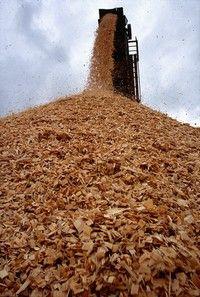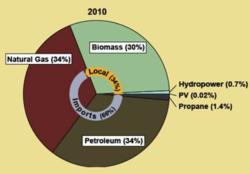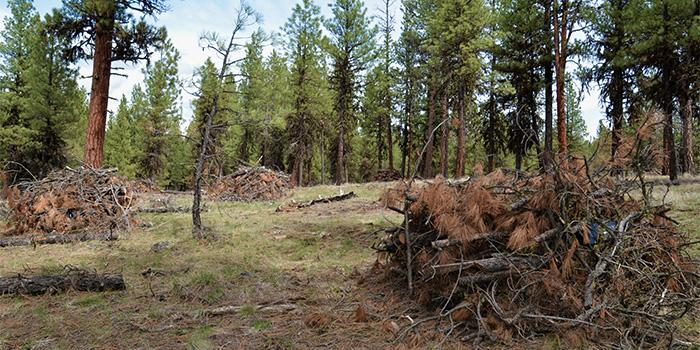Woody Biomass
California cap-and-trade expenditure deal benefits biomass
The California legislature has passed legislation that aims, in part, to support biomass plants within the state. Click here to read the full article from Biomass Magazine (September 1, 2016).
What is woody biomass?

However, "woody biomass" refers to trees, shrubs, bushes, or products derived from these woody plants that accumulate to an amount that is a hazard or disposal problem.
Why is woody biomass the largest local source of power?
Humboldt County has some of the world’s most productive forest lands. Forest byproducts are an important locally available resource. Materials, created from thinning forests and the chips and bark produced in sawmills, can be utilized in an emission-controlled power plant to produce energy. Humboldt has three bioenergy power plants that are an essential part of local infrastructure, providing many living wage jobs.
What power does Humboldt currently produce and use?

In 2010, 66% of Humboldt’s energy was imported and derived from non-renewable sources — natural gas and petroleum.
What are the benefits of using woody biomass?
Delivers distributed, baseload generation. Woody biomass energy production provides a continuous 24-hour power source, unlike solar or wind.
Promotes healthy forests and defensible communities. Woody biomass can be sourced from existing forest management practices, particularly fuels reduction prescriptions, that target diseased, bark beetle-killed, and/or over-crowded forests that contribute to historically uncharacteristic catastrophic wildfires.
Reduces emissions from wildfires or burn piles. Bioenergy facilities are equipped with air quality emission technologies. Woody biomass emissions are less than wood stoves and substantially less than burn piles or wildfires (currently, the fate of most woody biomass due to facility closures).
Reduces greenhouse gas emissions. Bioenergy production that uses materials from sustainably managed forests reduces long-term climate impacts by replacing fossil fuels.
Utilizes a local product. The ability for forest landowners to sell otherwise non-merchantable woody materials provides an economic incentive to steward and conserve local forests.
It’s renewable. Unlike coal, oil, and natural gas, which are fossil fuels that bring “new” carbon into the earth’s atmosphere, woody biomass is an abundant and renewable source of fuel. The burning of woody biomass and the growth of trees creates a closed-loop system and does not contribute additional carbon. Furthermore, woody biomass operations turn wood waste into electricity without compromising the essential cultural and habitat values that forests provide.
Local perspectives on Community Choice Aggregation and Woody Biomass
Matthew Marshall, Executive Director, Redwood Coast Energy Authority speaking on Monday Night Talk (Environment Show) on KMUD, May 30, 2016.
KMUD, Environment Show with Matthew Marshall
Biomass Context, PDF presentation, Yana Valachovic, County Director and Forest Advisor, UC Cooperative Extension-Humboldt/Del Norte.
Biomass Context presentation, Yana Valachovic, UCCE
Useful websites and resources
California Biomass Energy Alliance (CBEA)
The California Biomass Energy Alliance was created almost 20 years ago with a charter to promote biomass energy as a means to reach the environmental and economic goals of California. CBEA has supported California’s role as the largest state in the nation in the production of biomass power and will continue to do so by working closely with government, environmental, and industry partners to ensure sustained successes.
California Energy Commission—Waste to Energy & Biomass in California
The California Energy Commission is the state's primary energy policy and planning agency. Established by the Legislature in 1974, there are core responsibilities that guide the Energy Commission such as forecasting future energy needs and developing renewable energy resources.
Net energy output from harvesting small-diameter trees using a mechanized system
Publication produced by HSU professor Dr. Han-Sup Han and others on the amount of extra energy that can be generated after subtracting the total energy consumed to produce biomass energy.
Redwood Coast Energy Authority
Redwood Coast Energy Authority's purpose is to develop and implement sustainable energy initiatives that reduce energy demand, increase energy efficiency, and advance the use of clean, efficient and renewable resources available in the region.
The Schatz Energy Research Center (SERC) on California’s North Coast works to establish clean energy technologies in society. They specialize in renewable energy, energy efficiency, and hydrogen energy systems. Their work involves research and development, technology demonstration, project development, energy systems analysis, and education and training. In addition, they perform feasibility studies, resource assessments, and energy planning studies.
The Watershed Center, California Statewide Wood Energy Team
The California Statewide Wood Energy Team, administered by the Watershed Research and Training Center, works to enhance biomass utilization outreach, education, and stakeholder coordination and build capacity for wood energy projects.
Wildfire Protection and Biomass Utilization Program, County of Placer
The Placer County Wildfire Protection and Biomass Utilization Program was established in 2006 to help protect residents, communities, forests and important forest resources from the threat of wildfire and to efficiently manage and use biomass that is a large component of that threat.
The Woody Biomass Utilization Group at UC Berkeley is a collaborative outreach effort working to advance the understanding and use of wood and woody biomass. Part of the University of California system-wide Division of Agriculture and Natural Resources, the group is responsible for providing science-based information, technical assistance, and information about funding opportunities related to biomass utilization interests throughout the state of California.
Woody Biomass Factsheet #1: What is it - What do we do with it?
Woody Biomass Factsheet #2: Densified Wood Fuels
Woody Biomass Factsheet #3: Electricity from Woody Biomass
